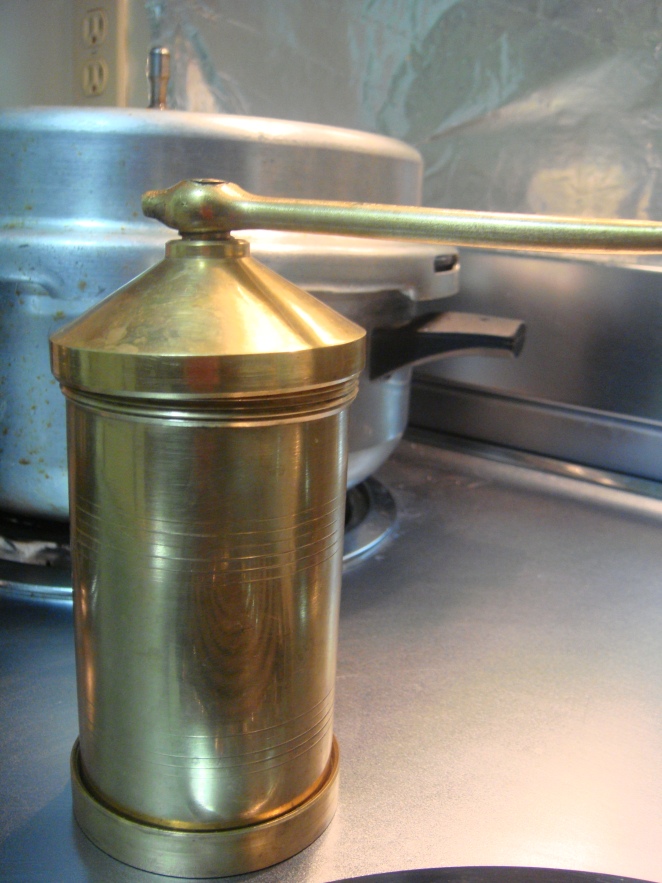Sevai – (Steamed Rice Noodles made from scratch)

Just the name conjures up so many memories of my childhood and of my grandmother and mother toiling in the kitchen, on saturday afternoons to make delicous sevai for all of us for the evening as well as for the night. Sevai was always thought as “labourious” as we were in a lovely joint family of 8 and cooking anything for all of us would mean laborious. But on the other side, it would be a joyous moment for me to sit and help my grandmother in the preparation and more particularly, in the partaking, which we would do all together.
My daughter had never seen me making fresh sevai as I would never attempt it when she was smaller. On one such vacation in Madras, amma had asked me what I wanted for dinner and I promptly told her “Sevai” and we thought , “well why not? ” As we were extruding the steamed balls in the “Sevai Nazhi” or “Sevai Press”, my daughter S, who was sitting near me, doodling on a piece of paper stopped short in complete awe. She couldnt believe that some thing so beautiful could come out of the Sevai Press. She immediatly wanted to taste the freshly pressed Sevai. My mom gave her a bit, and from then on she was hooked!!!
I had tried making Sevai at home last week, sans the Sevai Press. I used the traditional ones that we normally use for making Ribbon Pakoda etc and it looks like this:

INGREDIENTS:
2 cups of Boiled Rice.
Salt
Pinch of Hing
A spoon of Coconut Oil.
Sevai Press or Regular Nazhi or Press.
PREPARATION:
- Soak the boiled rice for 3 hours ahead. You could soak it even at 8 Am in the morning if you plan to make it for lunch. With the help of a grinder, grind it to a smooth paste adding enough salt . Use only as much water as is necessary.
- Since this involves extrusion etc, it is important that the rice is ground to a smooth paste.
- From here there are actually two methods – one which my mom in law uses and one that we have been traditionally using in my grandmother`s home. One option is to simply transfer this ground batter in to greased idli plates and steam then for 15 mins just as you would do for idlis.
(OR)
- Transfer the contents of the grinder in to a kadai, add a pinch of hing and a spoon of coconut oil and switch on the stove on medium low flame. Keep stirring it until the water is used to cook the batter and it comes together as one. It should look like this:

- Immediately shape this dough in to rough balls and place them on greased idli plates. Steam these balls for about ten minutes just like you would steam the idlis. This double cooking where we cook it once over the stove and once in the cooker,makes it much more easily digestible for old people and for kids alike. If you are out of time simply follow the earlier method of directly steaming the raw batter in the idli plates.
- Once you have steamed the batter/prepared dough balls you have to start the process of sevai extrusion.
- Briskly add the balls in to the sevai maker and press to get steaming hot noodles of rice sevai. Keep the unused balls tightly closed inside the pressure cooker as the heat is what helps in the easy pressing. Once they get cold, it would become very difficult to press.
- As the prepared sevai is pressed on to a plate, allow to cool before adding it to a wide mouthed bowl.
- Delicious home made Sevai is ready to be eaten plain or after seasoning as Pulikachal Sevai. Lemon Sevai or Coconut Sevai.

TIP:
When using the regular press, to extrude the sevai, the body of the press would be very hot and so I use a kitchen mitt to hold it with my left hand and then rotate the lever with my right.
Steaming hot oodles of noodles being sent to Monthly Mingle Ravishing Rice started by Meetha.